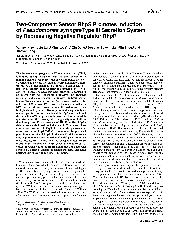摘要
The Pseudomonas syringae type III secretion system (T3SS) is induced during interaction with the plant or culture in minimal medium (MM). How the bacterium senses these environments to activate the T3SS is poorly understood. Here, we report the identification of a novel two-component system (TICS), RhpRS, that regulates the induction of P. syringae T3SS genes. The rhpR and rhpS genes are organized in an operon with rhpR encoding a putative TCS response regulator and rhpS encoding a putative biphasic sensor kinase. Transposon insertion in rhpS severely reduced the induction of P. syringae T3SS genes in the plant as well as in MM and significantly compromised the pathogenicity on host plants and hypersensitive response-inducing activity on nonhost plants. However, deletion of the rhpRS locus allowed the induction of T3SS genes to the same level as in the wildtype strain and the recovery of pathogenicity upon infiltration into plants. Overexpression of RhpR in the Delta rhpRS deletion strain abolished the induction of T3SS genes. However, overexpression of RhpR in the wild-type strain or overexpression of RhpR(D70A), a mutant of the predicted phosphorylation site of RhpR, in the Delta rhpRS deletion strain only slightly reduced the induction of T3SS genes. Based on these results, we propose that the phosphorylated RhpR represses the induction of T3SS genes and that RhpS reverses phosphorylation of RhpR under the T3SS-inducing conditions. Epistasis analysis indicated that rhpS and rhpR act upstream of hrpR to regulate T3SS genes.
- 出版日期2007-3
- 单位北京生命科学研究所
